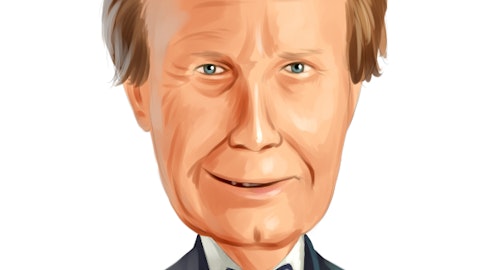Aviat Networks, Inc. (NASDAQ:AVNW) Q2 2023 Earnings Call Transcript February 1, 2023
Operator: Good afternoon, and welcome to Aviat Networks’ Second Quarter Fiscal 2023 Earnings Conference Call. At this time, all participants are in a listen-only mode. A question-and-answer session will follow the formal presentation. Please note this conference is being recorded. And now, I’d like to turn the conference over to your host, Mr. Andrew Fredrickson, Director of Investor Relations. You may begin.
Andrew Fredrickson: Thank you, and welcome to Aviat Networks’ second quarter fiscal 2023 results conference call and webcast. You can find our Form 10-Q, press release, an updated investor presentation in the Investor Relations section of our website at www.aviatnetworks.com along with a replay of today’s call in approximately 2 hours. With me today are Pete Smith, Aviat’s CEO, who will begin with opening remarks on the company’s fiscal second quarter, followed by David Gray, our CFO, who will review the financial results for the quarter. Pete will then provide closing remarks on Aviat’s strategy and outlook, followed by Q&A. As a reminder, during today’s call and webcast, management may make forward-looking statements regarding Aviat’s business, including, but not limited to, statements relating to financial projections, business drivers, new products and expansions, the impact of COVID-19 and the economic activity in different regions.
These and other forward-looking statements reflect the company’s opinions only as of the date of this call and webcast and involve assumptions risks and uncertainties that could cause actual results to differ materially from those statements. Additional information on factors that could cause the actual results to differ materially from the statements made on this call can be found in our annual report on Form 10-K filed with the SEC on September 14, 2022. The company undertakes no obligations to revise or make public any revision of these forward-looking statements in light of new information or future events. Additionally, during today’s call and webcast, management will reference both GAAP and non-GAAP financial measures. Please refer to our press release, which is available in the Investor Relations section of our website at www.aviatnetworks.com and financial tables therein, which include a GAAP to non-GAAP reconciliation and other supplemental financial information.
At this time, I would like to turn the call over to Aviat’s CEO, Pete Smith. Pete?
Pete Smith: Thanks, Andrew, and good afternoon, everyone. Thank you for joining us to review Aviat Networks’ results for the second quarter of fiscal year 2023. Aviat executed well against its plan this quarter, and we continue to position ourselves to benefit from growth around the world in 5G, rural broadband and private networks as well as drive meaningful bottom line improvement. In the second quarter of fiscal year 2023, Aviat delivered revenue of $90.7 million, which represents growth of 16.5% versus Q2 of last year. Record non-GAAP operating income margin of 12.5%. Adjusted EBITDA of $12.9 million, a 27% increase versus the same period prior year. Non-GAAP EPS increase of 32%. These results would not have been possible without the tireless dedication and execution of the Aviat team and our supplier partners.
. Let’s discuss some key highlights from the second quarter. The global 5G upgrade cycle continues to be a driver of Aviat’s business and outlook. Our recent 5G win with Bharti Airtel in India is officially underway as we began delivering products in the second quarter. We are excited about this win in India as it represents an entirely new customer and geography for Aviat and demonstrates the value that we can deliver to customers through our products and services. Elsewhere around the globe, we continue to gain 5G business through increased customer focus. Part of this growth has come from execution on replacement opportunities from our largest competitor. Globally, our share gain funnel against this competitor is approximately $60 million.
In fiscal year 2023, we have booked over $19 million in such opportunities year-to-date and have recognized over $8 million in year-to-date revenue. We will continue to execute on these opportunities to take share of demand. In terms of capturing new 5G opportunities, we recently announced the release of our better agnostic multi-band solution. This allows customers to leverage Aviat’s best-in-class E-band and multi-band solutions to seamlessly migrate their existing networks to 5G with lower incremental investments. This creates a large upgrade opportunity for Aviat as it helps to overcome high switching costs. The Aviat multi-band vendor agnostic solution works with existing third-party microwave radios and is detailed in our investor presentation.
Our solution provides extended distance and higher capacity alternatives versus competitive offerings. With regards to our rural broadband business, we continue to execute well and the Aviat store remains a point of differentiation for the company. We recently refreshed the store to expand the products offered beyond our microwave radios and accessories to include software products like our Health Assurance Software, or HAS and Frequency Assurance Software or FAS as well as integrating our access products from the Red Line acquisition. Some additional commentary on the government funding programs follows. We continue to anticipate RDOF, Rural Digital Opportunity Fund to begin flowing the first half of calendar year 2023 and Aviat to see RDOF related revenue in the second half of the calendar year.

Photo by Howard Bouchevereau on Unsplash
The recent RDOF authorization for an industry leader using fixed wireless access in their deployments is encouraging, and we anticipate more providers to use wireless technologies and the RDPF deployments moving forward. Note that we anticipate a long ramp for RDOF funding. Fortunately, Aviat is still benefiting from customer spend from the CAF, Connect America Fund and ARMA (ph) programs. On the horizon is the BEAD program, Broadband Equity, Access and Deployment, which we are optimistic about. The BEAD program has allocated $42.5 billion to expand high speed Internet access in all 50 U.S. states. There is much still to be seen about the implementation and allocation of the program, but this should be a large beneficiary of BEAD, which bodes well for Aviat.
In private networks, we are maintaining our leadership in North America and see increasing international opportunities. For example, in APAC, we secured a multi-year high margin win with our ECLIPSE platform for a national public safety network. The integration of the Redline Communications business which we now refer to as access products continues to go better than anticipated. We are improving our progress from a cost takeout perspective. And we are beginning to see cross-selling opportunities for Aviat backhaul into Redline accounts and vice versa. Moving on to the supply chain environment. We continue to see improvements for approximately 98% of our supply, we have returned to pre-crisis performance, last, we need 100%. Currently, we have 27 components to remain in allocation.
Note that it takes approximately 2,000 components to deliver our microwave system. Of the remaining components of allocation, semiconductor chips on the 28-nanometer node remains problematic. We’ve come a long way, but are not done derisking the supply chain. Fortunately, Aviat has been able to avoid significant supply chain interruptions through the crisis period. Throughout the supply chain crisis, Aviat has held elevated inventory levels. These elevated inventory levels started at the outset of COVID-19 and have persisted an increased through the recent China reopening. We have built resiliency to the third derivative of the supply chain, which is subject to the reopening risk. Based on the past few years of execution and building inventories, we will declare our peak inventory levels at Aviat and anticipate improvements over the next several quarters as lead times and location continue to moderate.
This quarter, we saw no missed revenue opportunity due to supply chain shortages. Aviat remains committed to building resiliency in our supply chain by proactively identifying at risk components and secondary suppliers. Our work in driving Redline’s manufacturing base over to Aviat’s a good demonstration of an opportunity where we believe we will see improved reliability results through a stronger supply chain. I will now turn the call over to David to review our financials before coming back for some final comments. David?
David Gray: Thank you, Pete, and good afternoon, everyone. During my remarks today, I’ll review some of the key fiscal 2023 second quarter financial highlights, noting our detailed financials can be found in our press release and 10-Q filed this afternoon. As a reminder, all comparisons discussed today are between second quarter fiscal 2023 and second quarter fiscal 2022, unless noted otherwise. For the second quarter, we reported total revenues of $90.7 million as compared to $77.9 million for the same period last year, an increase of $12.8 million or 16.5%, driven by strong growth in Asia-Pacific, Europe and Latin America as well as the contribution from the Red Line acquisition. North American revenue, which comprised 57% of the total revenue for the second quarter was $52.0 million, and international revenue was $38.7 million.
We continued our trend of trailing four quarter book-to-bill ratio above one started back in fiscal 2018. Gross margins for the quarter were 35.5% and 35.7% on a GAAP and non-GAAP basis as compared to prior year margins of 36.2% and 36.3% for GAAP and non-GAAP. Current quarter margins were weighed down by initial shipment of equipment for a large Asian 5G project. These project margins will improve substantially in subsequent quarters as we recognize revenue on higher margin services and software. Second quarter GAAP operating expenses were $22.6 million an increase of $2.7 million from the prior year, driven by the inclusion of Redline operating expenses and $0.9 million restructuring charge in the quarter. Second quarter non-GAAP operating expenses, which exclude the impact of restructuring charges, share-based compensation and deal costs were $21.0 million.
This is an increase of $1.8 million from the prior year, primarily due to the Red Line acquisition. On a like-for-like basis, we continue to manage costs aggressively. Second quarter tax provision was $3.1 million, essentially flat to last year. We continue to report our non-GAAP tax expense of $0.3 million per quarter based on a reasonable estimate of cash taxes we expect to incur. The company has over $500 million of NOLs manifested as the almost $90 million deferred tax asset on our balance sheet that will continue to generate shareholder value via minimal cash tax payments for the foreseeable future. We recorded second quarter GAAP net income of $6.0 million compared to $5.9 million last year. Second quarter non-GAAP net income, which excludes restructuring charges, FX impacts, share-based compensation M&A related costs and non-cash tax provision was $11.1 million compared to $8.5 million for the same period last year.
Second quarter non-GAAP EPS came in at $0.94 per share on a fully diluted basis compared to $0.71 per share for the same period last year, an increase of 32%. Adjusted EBITDA for the second quarter was $12.9 million an increase of $2.8 million or 27.4% from the prior year. Adjusted EBITDA margins were 14.2% for the quarter. Moving on to the balance sheet. Our cash and marketable securities at the end of the second quarter were $21.6 million from $22.9 million in the prior quarter. Accounts receivable continue to be impacted by limitations on ForEx availability in certain emerging markets, extending the collection cycle. We continue to leverage our balance sheet to mitigate supply chain risks via buffer stock and supplier deposits. Given the recent improvements in our supply chain, however, we will begin to unwind these investments in future quarters.
We continue to have a strong debt-free balance sheet, leaving us well positioned to execute our long-term plans. With that, I will turn it back to Pete for some final comments. Pete?
Pete Smith: Thanks, David. Before opening up for Q&A, I’d like to add a few comments and summarize our performance. Year-to-date, we have executed on our long-term growth drivers of 5G rural broadband and private networks. In North America and around the world, we continue to grow and capture additional share of wallet through our differentiated product, software and services offerings. We also remain focused on increasing profitability and generating meaningful shareholder value over the long term. Based on our results, the hard work and dedication of the Aviat team and the demand environment, we are raising our revenue and profit guidance for fiscal year 2023. We now anticipate revenue for fiscal year 2023 to be in the range of $340 million to $347 million and adjusted EBITDA for the fiscal year 2023 to be in the range of $45 million to $47.5 million.
This is an increase on both the lower end and the higher end of guidance for both figures. With that, operator, let’s open the call for questions.
See also 20 Stocks That Are Aggressively Buying Back Shares and 11 Most Undervalued Blue Chip Stocks To Buy .
Q&A Session
Follow Aviat Networks Inc. (NASDAQ:AVNW)
Follow Aviat Networks Inc. (NASDAQ:AVNW)
Operator: Certainly. And our first question comes from the line of Scott Searle from ROTH. Your question, please.
Scott Searle: Hey. Good afternoon. Thanks for taking my questions. Nice job on the quarter. Hey Pete, maybe to jump right in on gross margins. None of you were down sequentially in the quarter. Product revenue, product gross margins were up. I’m wondering if you could give us a little bit more color on that, particularly given that you’ve got some initial contribution from — which tends to be lower gross margin. And where we can expect that to go over the next couple of quarters as you start to see more normalization on the component side? And then, on the other side of the ledger, the service gross margin seems they were down, any onetime items or something that we should be thinking about in that segment of the business going forward?
David Gray: Hey, Scott. This is David. I’ll take that. So actually, I’ll start in reverse on the service margins. So service margins tend to be a bit volatile to begin with, but they’re subject to kind of some of the secrecies of revenue recognition standard. We have to go through a process of repricing every quarter, which impacts the allocation of revenue across services and equipment. And this quarter, we had a, let’s call it a carve-out from services that ended up in equipment. It was kind of bucket to bucket. So that did impact our service margins this quarter and also positively impacted equipment and kind of masked the dilutive impact of that large Tier 1 project that we talked about that, again, that should be a temporary impact to this quarter and improve sequentially as we start mixing in higher margin services and software into that project.
So it’s a fit on idiosyncratic, but fundamentally, I think we’re in good shape, and things are looking more positive going forward.
Pete Smith: And Scott, to just add, when we won the Bharti Airtel business, we said we were going to crank up our cost reduction machine that takes a little while, and we’re going to get the volume benefits. So we see improvements coming on the margins side, and we thought taking the Bharti business and improving it over the right time — over time was the right thing to do.
Scott Searle: Got you. Very helpful. And maybe just to follow up on that, Dave. I mean, how should we be thinking about gross margins, though, over the next couple of quarters in aggregate, should they be starting to tick up then as we start to see some alleviated pressure on the component and cost and expedite front offset a little bit by India. Is that the best way to be thinking about it?
David Gray: Yeah. I think that’s a good way to think about it. It should — definitely be moving north from where we were this quarter. I think the back half looks relatively strong. Of course, there’s always some give or take there. But in the — certainly, probably at least 100 basis points higher than what we currently had this quarter. And I think for the full year, we’ll probably still end up higher than what we were for full year fiscal ’22.





